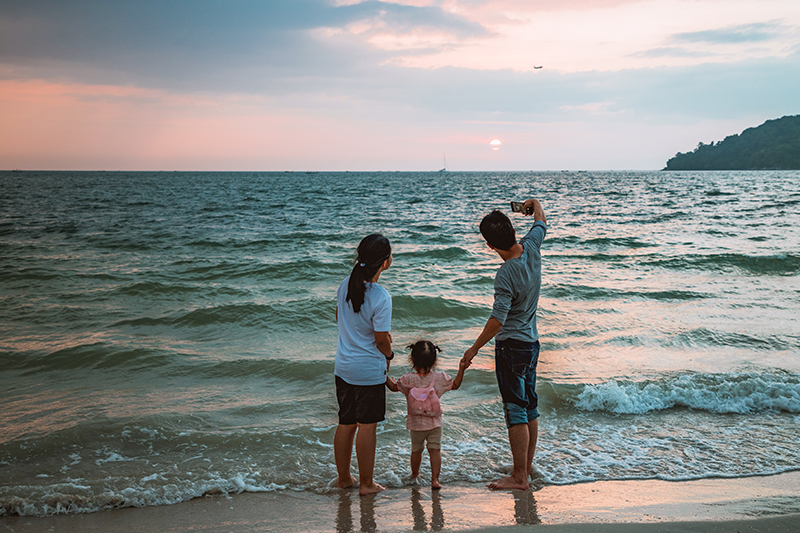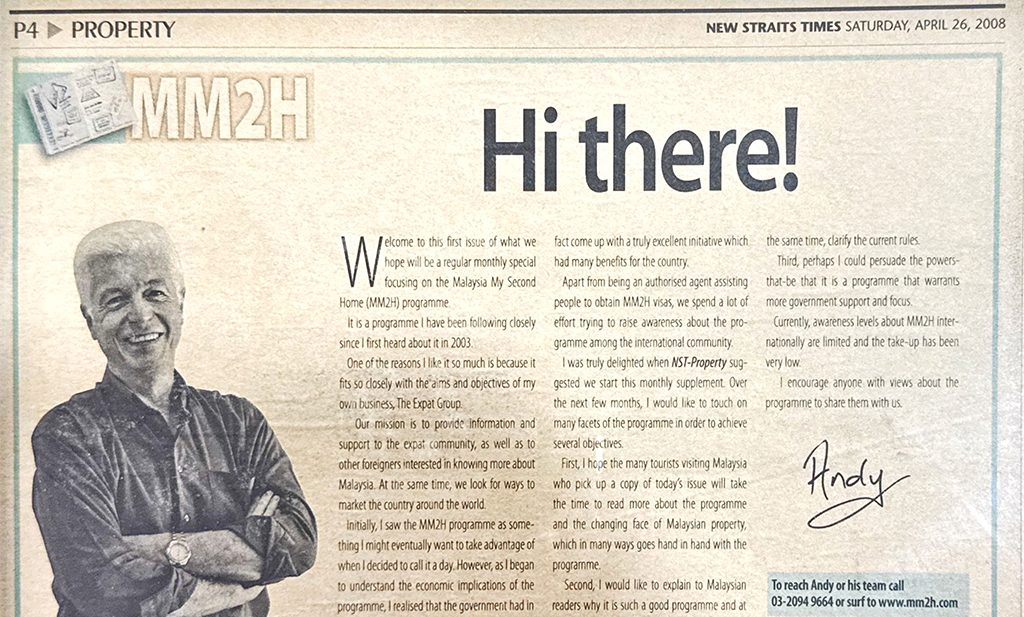From The Silver Hair Programme To Malaysia’s Flagship Long-stay Visa
The journey of Malaysia’s well-known Malaysia My Second Home (MM2H) programme began about thirty years ago, long before it became the country’s flagship long-stay visa. Over the years, it has evolved through various changes – some exciting, others frustrating for those involved in promoting it. Yet through it all, MM2H has remained a welcoming path for people who wish to make Malaysia their home away from home.
In its early days, I was regularly invited to government meetings to share feedback gathered from the many thousands of people our organisation connects with. It’s been a long journey, and one we continue to support wholeheartedly.
BEGINNINGS – THE SILVER HAIR PROGRAMME
The concept of retirement visas emerged in the 1980s and Malaysia was one of the first countries to introduce one. It was called the Silver Hair Programme and was launched in 1996, with a name that reflected its intended audience. The idea was to invite financially independent foreigners aged 50 and above to live in Malaysia for an extended period. They could enjoy the country’s tropical climate, friendly people, and relatively low cost of living, while contributing modestly to the economy through long-term spending and property purchase and rental. While the concept was progressive for its time, the programme suffered from limited marketing and some unfriendly conditions, resulting in a low number of applicants.
THE BIRTH OF MM2H IN 2002
It all changed in 2002, when the government renamed the programme and set some clear and more attractive conditions. It was renamed as the Malaysia My Second Home (abbreviated to MMSH, later MM2H) programme. Over the years, the name has caused some confusion, as many assumed it was only for those seeking a second home in Malaysia, when in fact people could fully relocate here – and many did. However, it is now well known as a long-term residency visa and attracts wide popularity.
MM2H was administered under the Ministry of Tourism, working closely with the Immigration Department, and offered successful applicants a renewable 10-year Social Visit Pass with multiple entry privileges.
After ten years, the government reported that some 20,000 people held the visa, although not all of them lived in Malaysia. For example, China topped the list of countries holding the most visas. Many Chinese applicants applied because purchasing property here allowed them to use the MM2H visa instead of the then highly restrictive tourist visa. Others came from troubled countries and saw Malaysia as a safe haven – a place they could relocate to if conditions at home deteriorated.
The visa programme grew steadily, with some minor changes, until 2019. For those aged 50 and above, the requirements were more lenient than for younger applicants. The fixed deposit was set at RM150,000, and the qualifying monthly income at RM10,000, attracting a reasonably affluent group of retirees. The government allowed visa holders to work under certain conditions as they recognised some brought skills that could help Malaysia, but this aspect of the visa was never fully realised.
Government marketing of the visa was relatively low-key and approved agents for the visa spearheaded most of the marketing efforts, aided by word of mouth. It helped when the popular magazine International Living ranked the MM2H visa as one of the best in the world and the best in Asia.
By 2017 new approvals had reached around 6000 a year and by 2019 the total number of participants was just over 48,000. The programme was contributing billions to the Malaysian economy and had become a success story.

BIG CHANGES: 2019 – 2022
In 2018 there was a significant change in the government when the party which had ruled the country for some sixty years was ousted. The new Prime Minister, Mahathir Mohamed, who had been elected for the second time, expressed concerns about the Forest City development in Johor that was targeting Chinese buyers. He made clear he did not like the idea of this part of Malaysia being occupied by Chinese citizens. Soon after, an extra step was added to the approval process, which slowed down approvals. This was followed by many rejected applications. Then came the Covid-19 pandemic, during which the programme was suspended pending a review. This not only hurt its reputation but also caused many approved agents to face serious financial difficulties.
When MM2H reopened in late 2021, it did so under far stricter conditions, higher income thresholds, larger fixed deposit requirements, and tighter security vetting. The Minister also announced a participation cap of 1% of the Malaysian population (around 300,000), although after more than two decades, the programme had never come close to reaching that number of applicants.
The Minister also indicated that existing visa holders might be required to renew their visas under the new conditions. It is worth noting that throughout the programme, the government had continued to renew people’s visas under the same conditions that originally applied. So, concerns about being forced to meet new conditions have been unwarranted, and on the one occasion it was raised, the proposal was quickly reversed.
These changes to the terms and conditions were intended to attract more high-net-worth applicants. They had to show for at least RM40,000 in monthly income and be able and willing to place a fixed deposit of RM1 million. It was not a success and new applications plummeted. In September 2023 it was announced that only 1900 people had been approved under this programme in the twenty months since it was relaunched. During this time there were widespread calls for revision of the programme’s terms and conditions.
THE LATEST VERSION: 2023 – PRESENT
At the end of 2022, a new government came to power and pledged to ease the programme’s terms. By the end of 2023, a revised version was introduced with more favourable conditions – though still not as lenient as the original programme. The programme was suspended and MM2H agents were required to apply for their business approval again under stricter conditions, that included the requirement to place a RM200,000 bank guarantee. Toward the end of 2024, the visa program was reopened for new applications.
Also, it was announced that the total number of visa holders was now over 58,000, although the significant jump from the 48,000 announced previously in 2019 was not explained. On the face of it did not reconcile. According to official announcements, only some 1900 people had been approved under the previous version of the visa, which did not tally with the large jump in total numbers.
The revamped programme was realigned away from being a mainly retirement visa to one that focused more on its economic contribution. The new visa came with several significant changes, including purchasing property as well as a Platinum version that allowed for investment and employment.
There were three tiers for the national visa: Silver, Gold, and Platinum, designed to offer different levels of benefits and requirements. The programme offered longer visa lengths for larger fixed deposits and the Platinum version, allowing people to work.
Sabah and Sarawak continued to issue their own MM2H visas for those who wanted to live in these states and thee visas have different conditions. There was also a special visa introduced for the Forest City development in Johor, which had been designated a Special Finance Zone, offering more favourable terms.
This mix was aimed at attracting applicants with larger savings who could immediately contribute to Malaysia’s broader economic goals, as well as investors.
A SUCCESS STORY WITH ROOM TO GROW
The visa programme has come a long way since its launch. The minister has advised there will be no major changes to the rules, although we hope some of the weaknesses of the programme can be addressed.
Many other countries have launched their own version, although most are targeted more towards the huge retirement sector. Thailand, Indonesia, and the Philippines have all launched successful visa programmes specifically aimed at wealthier retirees. This has increased the competitive environment, but for many Malaysia has always had special appeal. Its advanced infrastructure, low cost of living, combined with its widespread spoken English make it especially attractive. Approved visa holders also say they find Malaysians very friendly, they love the food, the weather and the many tourist destinations. Though it has had its ups and downs, the visa programme has contributed billions of ringgits to the economy and strengthened Malaysia’s image as one of Asia’s most welcoming countries for those seeking a second home.

